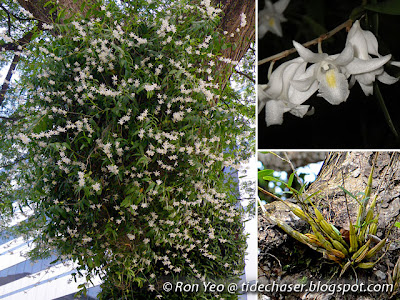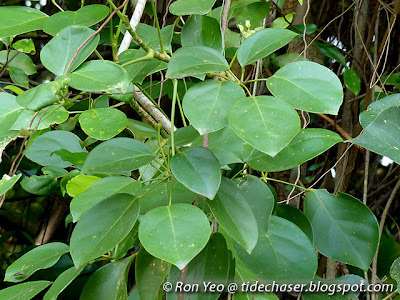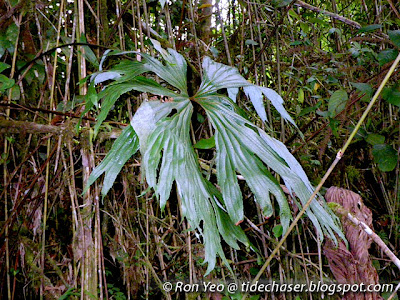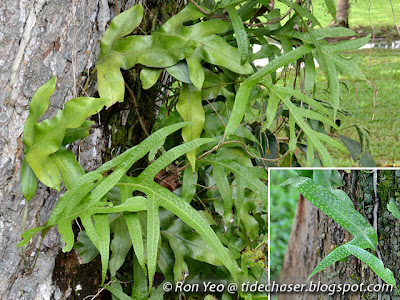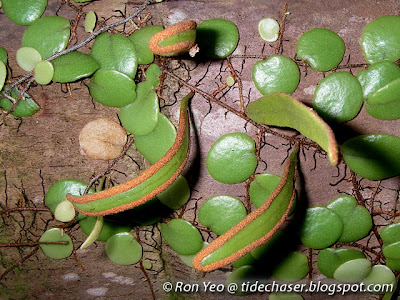Semakau Landfill is Singapore's only landfill in use, and is also the world's first offshore landfill created entirely from the sea.

However, what many people do not know is that this island still has a natural seashore, with a wide variety of marine animals that is accessible if you participate in an intertidal walk during low spring tide.
The current island is reclaimed from two islands - Pulau Semakau and Pulau Sakeng. The two islands were joined together with a 7.1km rock bund, forming an area of 350 hectares. Previously, the two islands were home to small fishing villages with stilt houses, but the islanders were relocated to the mainland from 1987 to 1991.
During the construction of the landfill, a monitoring programme was established to monitor the impact on the surrounding coral reefs, and silt screens were erected to minimise siltation. As such, the intertidal area of the original Pulau Semakau still harbours very rich biodiversity.

400,000 mangrove seedlings were also planted to replace the forests that were destroyed during the construction.
The landfill started operation on 1 April 1999, it is estimated that it can last till 2045. In 2005, the National Environment Agency (NEA) which manages the landfill decided to open up the island for recreational activities. Since then, several nature groups have organised trips to the island, the most popular trip would be the intertidal trips to see the amazing shore life.
Dos & Don'ts
What to Expect at a Semakau Intertidal Walk
The trip usually begins with meeting at the ferry teriminal, and some trips may require you to meet at the jetty as early as 5am in the morning! The boat ride from Marina South Pier to Semakau Landfill takes about an hour, while the boat ride from Pasir Panjang or West Coast may take about 30 min.

If you join a morning trip, you will be required to walk for about 30 min along the road on the island to reach the shore entrance. For afternoon trips, NEA will usually provide transport to the shore entrance. Remember to go to the toilet before the walk, as out on the seashore you will have to survive without toilets for 2 hours.

You will need to walk through a mosquito-infested forest to reach the seashore. This forest is a secondary forest with a mixture of kampong trees, secondary forest plants, freshwater swamp species, and coastal forest plants.

For example, this Aquatic Ginger (Alpinia aquatica) is a freshwater swamp species that is critically endangered in Singapore. Scientists have collected the seeds and saplings from Semakau, and propagated them on mainland Singapore. This plant with delicate flowers is planted in freshwater ponds for ornamental purposes.

The Malay Apple (Syzygium malaccense) is an exotic species common planted in kampongs last time for its juicy fruits and pretty flowers.

The Sea Derris (Derris scandens), a coastal climber, is also critically endangered in Singapore. Sap from the stem is used as a fish poison.
It takes about 5 min to reach the seashore. At the edge of the shore, several coastal plants can be seen. These plants do not grow in areas regularly inundated with sea water, but higher areas that get salt sprays. Hence, they are usually adapted with smooth and glossy leaves that allow salt splashed onto them to be swept away quickly by the wind. Most of them have leathery leaves to retain water, as the sandy or rocky substrate of the shore area does not retain moisture well.

The Seashore Pandan (Pandanus odorifer) is one coastal commonly seen on Semakau. The leaves have lots of spines along the edges, and are used for weaving hats and mats, and for thatching. The fruits look somewhat like pineapple fruits. The male flowers yield an essential oil used to scent clothes.

The Sea Lime (Ximenia americana) is a common coastal shrub/tree which is occasionally a root parasite, even on its own species. The pulp of the fruit is sometimes eaten, though it is mildly poisonous (cyanide).

The Sea Hibiscus (Talipariti tiliaceum) is a common coastal tree with heart-shaped leaves. The flowers are yellow, turning orange or red towards the end of the day, and will be shed usually by the next day. The fibre from the bark is used to make ropes and caulk boats.
A little away from the coastal forest are a few mangrove trees. These plants are specially adapted to survive in areas inundated with sea water during high tide. They can either block salt at the root level, or excrete salt through glands on their leaves. Most have roots spreading over a wide area for stability on the soft substrate, and have aerial roots to take in oxygen from the atmosphere as the waterlogged soil lacks air.

Bakau trees (Rhizophora spp.), such as the Bakau Pasir (Rhizophora stylosa), can be found here, and they are easily recognised with their prop roots. These plants can block most of the salt at the root level, and accumulate the salt that got into them in old leaves. The thin and long structures hanging from the trees are the seedlings, not fruits. Mature seedlings are dispersed by water, floating horizontally for a few weeks, during which the root (lower part) will absorb water and become heavier, eventually causing the seedling to tip and float vertically. As the tide goes down, the vertically-oriented seedling will sink into the mud or other suitable substrates. The wood is hard and heavy, and is used for making charcoal. Young seedlings are also edible.
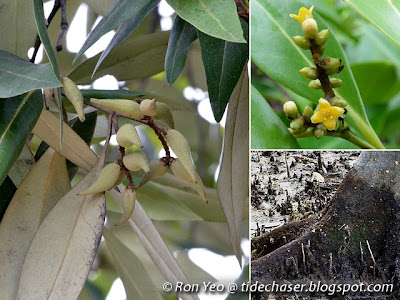
Some Api-api Putih saplings (Avicennia alba) have also established themselves here. "Api-api" means "fire-fire" or "firefly" in Malay, as some Avicennia species are noted to attract fireflies. Research indicated that roots of Avicennia species also exclude some salt from entering the plant. Salt glands on the leaves excrete part of the remaining quantity of salt which was not excluded at the roots. The wood of this plant is used as firewood and construction timber. The fruits are cooked and eaten.
Several animals can be found here too.

The Porcelain Fiddler Crab (Uca annulipes) is one of them. A male fiddler crab has an enlarged claw, which it waves the claw to attract the females and to ward off other males. Fiddler crabs feed on detritus, which are basically tiny bits of organic particles, and the male can only feed with its small claw (the big one is too cumbersome) and as it is feeding, it looked like it's playing a fiddle, and hence the common name. The females have two small equal-sized claws, and thus can eat faster - for a good reason as they need to lay eggs.

There are lots of Zoned Horned Shell (Batillaria zonalis) on the shore. They are like the vacuum cleaners of the shore, feeding on algae and detritus. They are one of the many reasons why visitors should follow the guide's trail, so as to minimise trampling on the many animals living on the shore.

Some of the shells are not occupied by living snails, but by hermit crabs instead, such as these Tidal Hermit Crabs (Diogenes spp.). Unlike the crabs we eat which have a hard shell over their entire bodies, hermit crabs have a long soft abdomen. Only the front part of the hermit crab's body is protected by a hard shell. To protect its soft butt, a hermit crab needs to tuck it into an empty snail shell. As they grow older, they will need to find bigger shells. Interestingly, the genus name of these hermit crabs came from the Greek philosopher, Diogenes of Sinope, who lived in a barrel.
There is a small patch of rocky shore, and some animals can be found here, living among the rocks. Most of them are found hiding under the rocks from the hot sun in the day to prevent dehydration.

Rock Crabs (Leptodius spp.) are common here, and are usually under the rocks. These small crabs have spoon-tipped pincers, believed to help them in scraping off algae from rocks to feed on.

Many Nerites (Nerita spp.) can be found here as well. They feed on the algae on the rocks. Under the hot sun, they will usually keep still and not move much, hiding in shaded areas to avoid dehydration. They have a hard shell to deter predators from eating them. The above is a Chameleon Nerite (Nerita chamaeleon), so named for its variable colours.

As you walked further out, you may encounter numerous Sand-sifting Stars (Archaster typicus) on the sand. This is possibly the most common sea star in Singapore, and hence many nature guides also call it the common sea star. It has many common names though, but I personally prefer to call it the sand-sifting sea star, as I thought the name itself tells the story of how the sea star behaves - it sifts among the sand to avoid predation and to forage for detritus to feed on. Unlike most other sea stars, the Sand-sifting Stars have a rather interesting reproduction behaviour - males are often found stacked on top of the females, and the pairing may last for up to 2 months before the eggs and sperm are released into the water. The reproductive organs do not meet, and hence this behaviour is termed "pseudocopulation" - in other words, "fake sex". This behaviour apparently increases the chance of fertilisation though.

Occasionally, the Mangrove Horseshoe Crab (Carcinoscorpius rotundicauda). Horseshoe crabs are very ancient animals, and are said to have been around for more than 400 million years! They have an interesting way of dealing of bacterial infection - their blood will the bacteria and become gel like. Scientists these days use a substance extracted from the blood to test for bacteria on surgical instruments and also some drugs. And scientists from NUS have developed a way to clone this substance, so that we do not have to harvest from the wild as much.

There will be lots of sponges (Phylum Porifera) at the sandy area just before you enter the seagrass meadow. Sponges are simple animals which has lots of tiny holes and a few bigger holes on them. To feed, they suck water through their tiny holes and they will pick out the edible particles. The filtered water will then be pushed out of the big holes. Do you know that bathroom sponges used to be made from sea sponges? Nowadays most sponges were made from petroleum though. Take note that most sea sponges are poisonous and contain tiny glass-like bits though, and are not suitable to be made into bathroom sponges.

You will then need to wade in knee-height water across the seagrass meadow. Seagrasses are flowering plants growing in the sea. They are the only plants that can survive fully submerged in sea water. Seagrasses are very important to the marine ecosystem, as they provide lots of food and hiding places for small animals. Hence, it is something like a nursery ground for many marine species.

Many different types of seaweed can also be found here. Unlike seagrasses, they are algae and do not flower. Also, they do not have proper roots to absorb nutrients from the ground, but have simple structures call "holdfast" to hold onto rocks and other structures. Many animals also feed on seaweed, making them an important part of the ecosystem too. They are a few main groups of seaweed here, grouped according to their colour - the brown algae, the red algae, the green algae and the blue-green algae (which is actually a bacteria). The above photo shows a Fan Seaweed (Padina sp.) among some Tape Seagrass (Enhalus acoroides).
Sometimes, several species of sea cucumbers can be found in the seagrass meadow or at the sandy areas near its edges.

The Sandfish Sea Cucumber (Holothuria scabra) is one of the most commercially valuable species found in local waters. Often eaten as a delicacy in Chinese restaurants, they are sometimes over-harvested in the areas where they can be found. This species burrows into the sand, using their oral tentacles to gather tiny food particles in the sand. Their sand-like coloration allows them to camouflage with the surrounding sand.
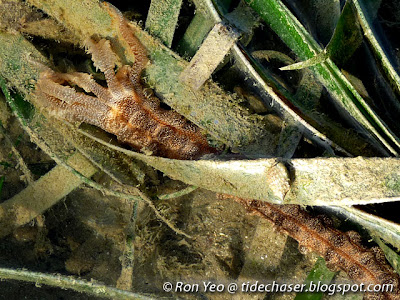
This Synaptid Sea Cucumber (Opheodesoma sp.) can grow to over 1.5m long, and is usually found in seagrass meadows. They appear worm-like without tube feet. Instead, they have tiny hook-like structures on their skin, which feel somewhat sticky to the touch and allow the animal to hold on to rocks or seaweed and seagrass. When are usually seen with their oral tentacles extending and lashing around, picking up organic matter from their surroundings.

The Dragonfish Sea Cucumber (Stichopus horrens) is commonly found in seagrass meadows and adjacent reef flats. It has numerous spiny bumps on its body. While the entire animal is seldom collected for food, natives in the pacific are known to cut it open and its intestines can be eaten raw, sometimes with a bit of lemon. The animal is then returned to the sea, where it will regenerate its lost intestines. The body fluid of this sea cucumbers is also harvested to make air gamat, a traditional Malay tonic used to aid healing, especially for women after delivery.

Away from the seagrass meadow is a reeflat with firm and compact sand, lots of coral fragments and numerous tide pools. The tide pools usually host numerous organisms, as they do not dry out during low tide.

Several giant carpet anemones (Stichodactyla gigantea) can be found in this zone. These sea anemones have sticky tentacles which sting small animals that have gotten too close to them. The tentacles will then transport the prey, acting like a conveyor belt system, to bring it to the centre of the animals where the mouth is located.

The Noble Volute (Cymbiola nobilis), a large sea snail, can also be found here, and sometimes, they can be seen laying eggs - a very good sign indicating that these snails were doing well here! This snail is a fierce predator of clams and other smaller snails. It will embrace its prey with its huge foot to attempt to suffocate it. When the prey eventually opens up to breathe, the volute will feed on it.
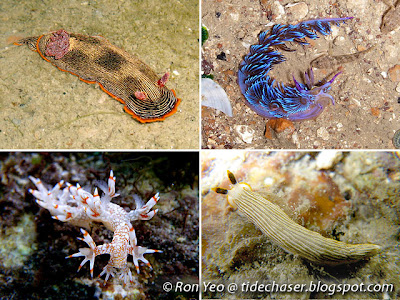
Several nudibranchs (clade Nudibranchia) can be found on Semakau. The term "nudibranch" means "naked gills", refering to the exposed flower-like gills on the back of most species. They are sea slugs - sea slugs are basically snails with very reduced shells, internal shells or no shells at all. Many nudibranchs are toxic, deriving the toxins from their prey, such as sponges. Like other sea slugs, they are hermaphrodites with both male and female reproductive organs. To mate, they usually get into a "69" position side by side and fertilise each other. The reproductive organs are located behind the head on the right side.

The Funeral Nudibranch (Jorunna funebris) is a common nudibranch found on Semakau. It gets its common name from the black and white coloration. It feeds on a blue sponge (Neopetrosia sp.), and its egg ribbons are white in colour.

Several species of flatworms can also be found here. The above is an Acanthozoon Flatworm (Acanthozoon sp.). It is very common in local waters, but somehow has not been scientifically described yet. Being very flat, it can easily slide into small cracks and gaps among rocks to seek for food and hide from predators. It can also swim by flapping the sides of its body.

Sometimes, octopuses (Order Octopoda) can be seen too. The octopus is said to be one of the smartest invertebrates, and are known to be able to solve puzzles and learn by observation! It is also able to spray a black ink to confuse predators. In addition, octopuses have specialised skin cells which allow they to change their color, opacity, and reflectiveness to blend in with the surrounding and also to communicate with other octopuses.
.JPG)
Hairy Crabs (Pilumnus vespertilio) are very common here as well. The tiny hair on its exoskeleton traps sand and mud, allowing it to blend nicely into its surrounding. This is not the edible Shanghainese Hairy Crab though. Studies in the early 1980s revealed that this crab is sometimes poisonous, probably from a red algae it feeds on. There are also suggestions that this crab also feeds on zoanthids sometimes, which makes it poisonous sometimes too.

Occasionally, the Upside-down Jellyfish (Cassiopea sp.) can be seen. The main photo shows it sideways, while the smaller photo shows how it usually looks like with the tentacles facing upwards. This jellyfish has symbiotic algae which can make food from the sun and pass on some of the nutrition to the former. The algae apparently photosynthesize better with the jellyfish being upside-down.

Moving on towards the reef edge, more hard corals can be seen. Hard Corals (Order Scleractinia), which have a hard calcium carbonate skeleton, mostly live in a colony (though there are solitary ones as well). It's like they live in HDB flats or condominium, and basically each little holes you see on the coral has a little coral polyp living inside. Most of our corals get their colour from symbiotic algae called zooxanthallae, which like the ones in the upside-down jellyfish, provides food for the corals. Most corals also feed on plankton and smaller organic particles. The coral polyps are able to capture food with their tentacles, which contain stingers to paralyse the tiny animals. Coral reefs are basically the huge structures formed by these coral colonies. They are very important to the marine ecosystems, as they provide food and hiding places for animals, and also structure for plants, algae and sessile animals to settle on.

Unlike the hard corals, the various species of Soft Corals (Alcyonacea) do not have the hard calcium carbonate skeleton. There are still colonial animals though, comprising lots of coral animals (aka polyps) connected by a shared tissue. Many of these colonies are known to be able to secrete chemicals to prevent other encrusting organisms from growing over them.

The Knobbly Sea Star (Protoreaster nodosus) is one of the bigger sea stars found on Semakau, and some can be more than 35 cm wide! This is perhaps also one of the prettier sea stars, as they occur in various colours, ranging from bright red, orange and pink to dull colours such as brown and beige. They have a hard, calcified body with large nodules on the top surface, which protects them from most predators except fish with sharp and powerful teeth, such as pufferfish and triggerfish. Indeed, every now and then I will see individuals with broken nodules or arms. Despite the big size, this sea star feeds mainly on microorganisms, although it has also been observed to feed on snails, clams, soft corals and sponges. Like most other sea stars, they feed by everting their stomach over their food and digestion takes place externally.

At the reef edge, there is a resident Fluted Giant Clam (Tridacna squamosa). This clam feeds on plankton and tiny organic particles in the water. At the same time, it harbours symbiotic algae in its body. The algae photosynthesize and pass on some of the food to the clam, and in return gain shelter and protection.

On luckier days, you may see Tigertail Seahorses (Hippocampus comes). Interestingly for seahorses, the males are the ones getting pregnant. Female seahorses lay their eggs into the males' brood pouches, and the little seahorses will eventually hatch in the pouches. Seahorses can be really well-camouflaged, especially when they are hiding among the brown seaweeds.
The intertidal walk usually lasts for about 1.5 to 2 hours. After which you will get to wash your feet with the water provided by NEA at the forest entrance. Then, you will be brought on a tour around the landfill on NEA buses, followed by a video presentation on how the landfill operates.
Other Available Nature Trips to Semakau
You can also so bird-watching, sports-fishing and stargazing at Semakau Landfill.
Some of the birds that can be seen there include:

The Great-billed Heron (Ardea sumatrana), which is the tallest bird in Singapore, reaching heights of more than 1m.

Two species of nightjars can be seen here, and the above is the Large-tailed Nightjar (Caprimulgus macrurus). This nocturnal bird feeds on insects.

The Little Tern (Sternula albifrons) can also be found here. It feeds by plunge-diving for fish.
Conserving Pulau Semakau
The landfill on Semakau can only last till about the year 2045, and hence it is important that Singaporeans try to reduce the amount of rubbish generated so as to lengthen its usage. The basic principles of "Reduce, Reuse, Recycle" hence plays an important part - Do reduce the amount of things you use, so as to reduce waste; as far as possible, reuse what you have, so that you do not generate rubbish; and if you cannot reuse any more, recycle them. If everyone practices these, we can be sure that Semakau Landfill can last for a longer period, and perhaps we will not have to create another landfill so soon.
At the same time, it is important that Singaporeans learn more about our marine ecosystems, either through nature walks, books or the Internet, as only when we understand something then we can better protect them. for those who have visited Pulau Semakau, do share your experience with your friends through blogs and photos, so that more people will know about the island. If you have the time, you can volunteer as a guide or in coastal cleanups too. And remember to also feedback about your positive experience on the island through the proper channels, such as news forums etc, so that the authorities will be aware of it.

However, what many people do not know is that this island still has a natural seashore, with a wide variety of marine animals that is accessible if you participate in an intertidal walk during low spring tide.
The current island is reclaimed from two islands - Pulau Semakau and Pulau Sakeng. The two islands were joined together with a 7.1km rock bund, forming an area of 350 hectares. Previously, the two islands were home to small fishing villages with stilt houses, but the islanders were relocated to the mainland from 1987 to 1991.
During the construction of the landfill, a monitoring programme was established to monitor the impact on the surrounding coral reefs, and silt screens were erected to minimise siltation. As such, the intertidal area of the original Pulau Semakau still harbours very rich biodiversity.

400,000 mangrove seedlings were also planted to replace the forests that were destroyed during the construction.
The landfill started operation on 1 April 1999, it is estimated that it can last till 2045. In 2005, the National Environment Agency (NEA) which manages the landfill decided to open up the island for recreational activities. Since then, several nature groups have organised trips to the island, the most popular trip would be the intertidal trips to see the amazing shore life.
Dos & Don'ts
- Contact NEA to find out which nature group is organising trips to Semakau Landfill, as only these groups are allowed to enter the island.
- Ensure you reach the jetty (usually Marina South Pier, West Coast Pier or Pasir Panjang Ferry Terminal) on time, or the trip may be delayed, or the boat may leave without you. If you are driving, there is a small carpark at the pier. If you are coming by public transport, check the SBS website for the bus timing.
- In case of security checks, everyone has to bring their IC along, and if the children are too young, they will need to bring along their student concession card. Foreigners will have to bring their passport and work permit.
- Please wear covered shoes, such as diving booties, water shoes, school shoes or old sport shoes for the shore exploration. No slippers or sandals will be allowed on the shore, as there could be sharp rocks, muddy ground and poisonous organisms. Be prepared to get your shoes wet and muddy, as you will need to cross a seagrass meadow with knee height water, and the forest trail may be waterlogged.
- Bring an extra pair of shoes/sandals to change into after the shore exploration, as your original footwear will be wet by then.
- Preferably you should be wearing long pants. e.g. light track pants etc. There could be mosquitoes and sandflies.
- Please bring insect repellent. Mosquito pads are usually not very useful for such outdoor activities as the mosquitoes and sandflies can be quite aggressive.
- Please bring a cap/hat in case of sunny weather, and raincoat/poncho in case of wet weather. Do not use umbrellas, as you will be a walking lightning conductor in the open seashore area. I would also recommend bringing a few plastic bags to keep your electronic products in case it rains.
- Even if it rains before the meeting time, do still proceed to meet at the pier, as it may not be raining on the island, or the rain may stop and we can do the walk.
- Bring water and some light snacks, as there are no vending machines and canteen vendors on the island.
- If you are prone to motion-sickness, remember to bring and take the medication before you board the boat.
- Bring a working torch just in case it is still dark or will get dark during the trip.
- Bring a camera along, but remember to have a plastic bag to keep it dry in case it rains.
What to Expect at a Semakau Intertidal Walk
The trip usually begins with meeting at the ferry teriminal, and some trips may require you to meet at the jetty as early as 5am in the morning! The boat ride from Marina South Pier to Semakau Landfill takes about an hour, while the boat ride from Pasir Panjang or West Coast may take about 30 min.

If you join a morning trip, you will be required to walk for about 30 min along the road on the island to reach the shore entrance. For afternoon trips, NEA will usually provide transport to the shore entrance. Remember to go to the toilet before the walk, as out on the seashore you will have to survive without toilets for 2 hours.

You will need to walk through a mosquito-infested forest to reach the seashore. This forest is a secondary forest with a mixture of kampong trees, secondary forest plants, freshwater swamp species, and coastal forest plants.

For example, this Aquatic Ginger (Alpinia aquatica) is a freshwater swamp species that is critically endangered in Singapore. Scientists have collected the seeds and saplings from Semakau, and propagated them on mainland Singapore. This plant with delicate flowers is planted in freshwater ponds for ornamental purposes.

The Malay Apple (Syzygium malaccense) is an exotic species common planted in kampongs last time for its juicy fruits and pretty flowers.

The Sea Derris (Derris scandens), a coastal climber, is also critically endangered in Singapore. Sap from the stem is used as a fish poison.
It takes about 5 min to reach the seashore. At the edge of the shore, several coastal plants can be seen. These plants do not grow in areas regularly inundated with sea water, but higher areas that get salt sprays. Hence, they are usually adapted with smooth and glossy leaves that allow salt splashed onto them to be swept away quickly by the wind. Most of them have leathery leaves to retain water, as the sandy or rocky substrate of the shore area does not retain moisture well.

The Seashore Pandan (Pandanus odorifer) is one coastal commonly seen on Semakau. The leaves have lots of spines along the edges, and are used for weaving hats and mats, and for thatching. The fruits look somewhat like pineapple fruits. The male flowers yield an essential oil used to scent clothes.

The Sea Lime (Ximenia americana) is a common coastal shrub/tree which is occasionally a root parasite, even on its own species. The pulp of the fruit is sometimes eaten, though it is mildly poisonous (cyanide).

The Sea Hibiscus (Talipariti tiliaceum) is a common coastal tree with heart-shaped leaves. The flowers are yellow, turning orange or red towards the end of the day, and will be shed usually by the next day. The fibre from the bark is used to make ropes and caulk boats.
A little away from the coastal forest are a few mangrove trees. These plants are specially adapted to survive in areas inundated with sea water during high tide. They can either block salt at the root level, or excrete salt through glands on their leaves. Most have roots spreading over a wide area for stability on the soft substrate, and have aerial roots to take in oxygen from the atmosphere as the waterlogged soil lacks air.

Bakau trees (Rhizophora spp.), such as the Bakau Pasir (Rhizophora stylosa), can be found here, and they are easily recognised with their prop roots. These plants can block most of the salt at the root level, and accumulate the salt that got into them in old leaves. The thin and long structures hanging from the trees are the seedlings, not fruits. Mature seedlings are dispersed by water, floating horizontally for a few weeks, during which the root (lower part) will absorb water and become heavier, eventually causing the seedling to tip and float vertically. As the tide goes down, the vertically-oriented seedling will sink into the mud or other suitable substrates. The wood is hard and heavy, and is used for making charcoal. Young seedlings are also edible.

Some Api-api Putih saplings (Avicennia alba) have also established themselves here. "Api-api" means "fire-fire" or "firefly" in Malay, as some Avicennia species are noted to attract fireflies. Research indicated that roots of Avicennia species also exclude some salt from entering the plant. Salt glands on the leaves excrete part of the remaining quantity of salt which was not excluded at the roots. The wood of this plant is used as firewood and construction timber. The fruits are cooked and eaten.
Several animals can be found here too.

The Porcelain Fiddler Crab (Uca annulipes) is one of them. A male fiddler crab has an enlarged claw, which it waves the claw to attract the females and to ward off other males. Fiddler crabs feed on detritus, which are basically tiny bits of organic particles, and the male can only feed with its small claw (the big one is too cumbersome) and as it is feeding, it looked like it's playing a fiddle, and hence the common name. The females have two small equal-sized claws, and thus can eat faster - for a good reason as they need to lay eggs.

There are lots of Zoned Horned Shell (Batillaria zonalis) on the shore. They are like the vacuum cleaners of the shore, feeding on algae and detritus. They are one of the many reasons why visitors should follow the guide's trail, so as to minimise trampling on the many animals living on the shore.

Some of the shells are not occupied by living snails, but by hermit crabs instead, such as these Tidal Hermit Crabs (Diogenes spp.). Unlike the crabs we eat which have a hard shell over their entire bodies, hermit crabs have a long soft abdomen. Only the front part of the hermit crab's body is protected by a hard shell. To protect its soft butt, a hermit crab needs to tuck it into an empty snail shell. As they grow older, they will need to find bigger shells. Interestingly, the genus name of these hermit crabs came from the Greek philosopher, Diogenes of Sinope, who lived in a barrel.
There is a small patch of rocky shore, and some animals can be found here, living among the rocks. Most of them are found hiding under the rocks from the hot sun in the day to prevent dehydration.

Rock Crabs (Leptodius spp.) are common here, and are usually under the rocks. These small crabs have spoon-tipped pincers, believed to help them in scraping off algae from rocks to feed on.

Many Nerites (Nerita spp.) can be found here as well. They feed on the algae on the rocks. Under the hot sun, they will usually keep still and not move much, hiding in shaded areas to avoid dehydration. They have a hard shell to deter predators from eating them. The above is a Chameleon Nerite (Nerita chamaeleon), so named for its variable colours.

As you walked further out, you may encounter numerous Sand-sifting Stars (Archaster typicus) on the sand. This is possibly the most common sea star in Singapore, and hence many nature guides also call it the common sea star. It has many common names though, but I personally prefer to call it the sand-sifting sea star, as I thought the name itself tells the story of how the sea star behaves - it sifts among the sand to avoid predation and to forage for detritus to feed on. Unlike most other sea stars, the Sand-sifting Stars have a rather interesting reproduction behaviour - males are often found stacked on top of the females, and the pairing may last for up to 2 months before the eggs and sperm are released into the water. The reproductive organs do not meet, and hence this behaviour is termed "pseudocopulation" - in other words, "fake sex". This behaviour apparently increases the chance of fertilisation though.

Occasionally, the Mangrove Horseshoe Crab (Carcinoscorpius rotundicauda). Horseshoe crabs are very ancient animals, and are said to have been around for more than 400 million years! They have an interesting way of dealing of bacterial infection - their blood will the bacteria and become gel like. Scientists these days use a substance extracted from the blood to test for bacteria on surgical instruments and also some drugs. And scientists from NUS have developed a way to clone this substance, so that we do not have to harvest from the wild as much.

There will be lots of sponges (Phylum Porifera) at the sandy area just before you enter the seagrass meadow. Sponges are simple animals which has lots of tiny holes and a few bigger holes on them. To feed, they suck water through their tiny holes and they will pick out the edible particles. The filtered water will then be pushed out of the big holes. Do you know that bathroom sponges used to be made from sea sponges? Nowadays most sponges were made from petroleum though. Take note that most sea sponges are poisonous and contain tiny glass-like bits though, and are not suitable to be made into bathroom sponges.

You will then need to wade in knee-height water across the seagrass meadow. Seagrasses are flowering plants growing in the sea. They are the only plants that can survive fully submerged in sea water. Seagrasses are very important to the marine ecosystem, as they provide lots of food and hiding places for small animals. Hence, it is something like a nursery ground for many marine species.

Many different types of seaweed can also be found here. Unlike seagrasses, they are algae and do not flower. Also, they do not have proper roots to absorb nutrients from the ground, but have simple structures call "holdfast" to hold onto rocks and other structures. Many animals also feed on seaweed, making them an important part of the ecosystem too. They are a few main groups of seaweed here, grouped according to their colour - the brown algae, the red algae, the green algae and the blue-green algae (which is actually a bacteria). The above photo shows a Fan Seaweed (Padina sp.) among some Tape Seagrass (Enhalus acoroides).
Sometimes, several species of sea cucumbers can be found in the seagrass meadow or at the sandy areas near its edges.

The Sandfish Sea Cucumber (Holothuria scabra) is one of the most commercially valuable species found in local waters. Often eaten as a delicacy in Chinese restaurants, they are sometimes over-harvested in the areas where they can be found. This species burrows into the sand, using their oral tentacles to gather tiny food particles in the sand. Their sand-like coloration allows them to camouflage with the surrounding sand.

This Synaptid Sea Cucumber (Opheodesoma sp.) can grow to over 1.5m long, and is usually found in seagrass meadows. They appear worm-like without tube feet. Instead, they have tiny hook-like structures on their skin, which feel somewhat sticky to the touch and allow the animal to hold on to rocks or seaweed and seagrass. When are usually seen with their oral tentacles extending and lashing around, picking up organic matter from their surroundings.

The Dragonfish Sea Cucumber (Stichopus horrens) is commonly found in seagrass meadows and adjacent reef flats. It has numerous spiny bumps on its body. While the entire animal is seldom collected for food, natives in the pacific are known to cut it open and its intestines can be eaten raw, sometimes with a bit of lemon. The animal is then returned to the sea, where it will regenerate its lost intestines. The body fluid of this sea cucumbers is also harvested to make air gamat, a traditional Malay tonic used to aid healing, especially for women after delivery.

Away from the seagrass meadow is a reeflat with firm and compact sand, lots of coral fragments and numerous tide pools. The tide pools usually host numerous organisms, as they do not dry out during low tide.

Several giant carpet anemones (Stichodactyla gigantea) can be found in this zone. These sea anemones have sticky tentacles which sting small animals that have gotten too close to them. The tentacles will then transport the prey, acting like a conveyor belt system, to bring it to the centre of the animals where the mouth is located.

The Noble Volute (Cymbiola nobilis), a large sea snail, can also be found here, and sometimes, they can be seen laying eggs - a very good sign indicating that these snails were doing well here! This snail is a fierce predator of clams and other smaller snails. It will embrace its prey with its huge foot to attempt to suffocate it. When the prey eventually opens up to breathe, the volute will feed on it.

Several nudibranchs (clade Nudibranchia) can be found on Semakau. The term "nudibranch" means "naked gills", refering to the exposed flower-like gills on the back of most species. They are sea slugs - sea slugs are basically snails with very reduced shells, internal shells or no shells at all. Many nudibranchs are toxic, deriving the toxins from their prey, such as sponges. Like other sea slugs, they are hermaphrodites with both male and female reproductive organs. To mate, they usually get into a "69" position side by side and fertilise each other. The reproductive organs are located behind the head on the right side.

The Funeral Nudibranch (Jorunna funebris) is a common nudibranch found on Semakau. It gets its common name from the black and white coloration. It feeds on a blue sponge (Neopetrosia sp.), and its egg ribbons are white in colour.

Several species of flatworms can also be found here. The above is an Acanthozoon Flatworm (Acanthozoon sp.). It is very common in local waters, but somehow has not been scientifically described yet. Being very flat, it can easily slide into small cracks and gaps among rocks to seek for food and hide from predators. It can also swim by flapping the sides of its body.

Sometimes, octopuses (Order Octopoda) can be seen too. The octopus is said to be one of the smartest invertebrates, and are known to be able to solve puzzles and learn by observation! It is also able to spray a black ink to confuse predators. In addition, octopuses have specialised skin cells which allow they to change their color, opacity, and reflectiveness to blend in with the surrounding and also to communicate with other octopuses.
.JPG)
Hairy Crabs (Pilumnus vespertilio) are very common here as well. The tiny hair on its exoskeleton traps sand and mud, allowing it to blend nicely into its surrounding. This is not the edible Shanghainese Hairy Crab though. Studies in the early 1980s revealed that this crab is sometimes poisonous, probably from a red algae it feeds on. There are also suggestions that this crab also feeds on zoanthids sometimes, which makes it poisonous sometimes too.

Occasionally, the Upside-down Jellyfish (Cassiopea sp.) can be seen. The main photo shows it sideways, while the smaller photo shows how it usually looks like with the tentacles facing upwards. This jellyfish has symbiotic algae which can make food from the sun and pass on some of the nutrition to the former. The algae apparently photosynthesize better with the jellyfish being upside-down.

Moving on towards the reef edge, more hard corals can be seen. Hard Corals (Order Scleractinia), which have a hard calcium carbonate skeleton, mostly live in a colony (though there are solitary ones as well). It's like they live in HDB flats or condominium, and basically each little holes you see on the coral has a little coral polyp living inside. Most of our corals get their colour from symbiotic algae called zooxanthallae, which like the ones in the upside-down jellyfish, provides food for the corals. Most corals also feed on plankton and smaller organic particles. The coral polyps are able to capture food with their tentacles, which contain stingers to paralyse the tiny animals. Coral reefs are basically the huge structures formed by these coral colonies. They are very important to the marine ecosystems, as they provide food and hiding places for animals, and also structure for plants, algae and sessile animals to settle on.

Unlike the hard corals, the various species of Soft Corals (Alcyonacea) do not have the hard calcium carbonate skeleton. There are still colonial animals though, comprising lots of coral animals (aka polyps) connected by a shared tissue. Many of these colonies are known to be able to secrete chemicals to prevent other encrusting organisms from growing over them.

The Knobbly Sea Star (Protoreaster nodosus) is one of the bigger sea stars found on Semakau, and some can be more than 35 cm wide! This is perhaps also one of the prettier sea stars, as they occur in various colours, ranging from bright red, orange and pink to dull colours such as brown and beige. They have a hard, calcified body with large nodules on the top surface, which protects them from most predators except fish with sharp and powerful teeth, such as pufferfish and triggerfish. Indeed, every now and then I will see individuals with broken nodules or arms. Despite the big size, this sea star feeds mainly on microorganisms, although it has also been observed to feed on snails, clams, soft corals and sponges. Like most other sea stars, they feed by everting their stomach over their food and digestion takes place externally.

At the reef edge, there is a resident Fluted Giant Clam (Tridacna squamosa). This clam feeds on plankton and tiny organic particles in the water. At the same time, it harbours symbiotic algae in its body. The algae photosynthesize and pass on some of the food to the clam, and in return gain shelter and protection.

On luckier days, you may see Tigertail Seahorses (Hippocampus comes). Interestingly for seahorses, the males are the ones getting pregnant. Female seahorses lay their eggs into the males' brood pouches, and the little seahorses will eventually hatch in the pouches. Seahorses can be really well-camouflaged, especially when they are hiding among the brown seaweeds.
The intertidal walk usually lasts for about 1.5 to 2 hours. After which you will get to wash your feet with the water provided by NEA at the forest entrance. Then, you will be brought on a tour around the landfill on NEA buses, followed by a video presentation on how the landfill operates.
Other Available Nature Trips to Semakau
You can also so bird-watching, sports-fishing and stargazing at Semakau Landfill.
Some of the birds that can be seen there include:

The Great-billed Heron (Ardea sumatrana), which is the tallest bird in Singapore, reaching heights of more than 1m.

Two species of nightjars can be seen here, and the above is the Large-tailed Nightjar (Caprimulgus macrurus). This nocturnal bird feeds on insects.

The Little Tern (Sternula albifrons) can also be found here. It feeds by plunge-diving for fish.
Conserving Pulau Semakau
The landfill on Semakau can only last till about the year 2045, and hence it is important that Singaporeans try to reduce the amount of rubbish generated so as to lengthen its usage. The basic principles of "Reduce, Reuse, Recycle" hence plays an important part - Do reduce the amount of things you use, so as to reduce waste; as far as possible, reuse what you have, so that you do not generate rubbish; and if you cannot reuse any more, recycle them. If everyone practices these, we can be sure that Semakau Landfill can last for a longer period, and perhaps we will not have to create another landfill so soon.
At the same time, it is important that Singaporeans learn more about our marine ecosystems, either through nature walks, books or the Internet, as only when we understand something then we can better protect them. for those who have visited Pulau Semakau, do share your experience with your friends through blogs and photos, so that more people will know about the island. If you have the time, you can volunteer as a guide or in coastal cleanups too. And remember to also feedback about your positive experience on the island through the proper channels, such as news forums etc, so that the authorities will be aware of it.


